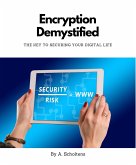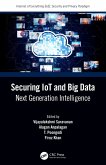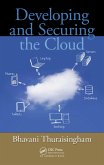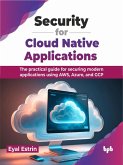Securing the Digital Frontier (eBook, ePUB)
Threats and Advanced Techniques in Security and Forensics
Redaktion: Sharma, Kavita; Shrivastava, Gulshan; Sagar, Anil Kumar; Nand, Parma; Sharma, Vishnu
188,99 €
188,99 €
inkl. MwSt.
Sofort per Download lieferbar

0 °P sammeln
188,99 €
Als Download kaufen

188,99 €
inkl. MwSt.
Sofort per Download lieferbar

0 °P sammeln
Jetzt verschenken
Alle Infos zum eBook verschenken
188,99 €
inkl. MwSt.
Sofort per Download lieferbar
Alle Infos zum eBook verschenken

0 °P sammeln
Securing the Digital Frontier (eBook, ePUB)
Threats and Advanced Techniques in Security and Forensics
Redaktion: Sharma, Kavita; Shrivastava, Gulshan; Sagar, Anil Kumar; Nand, Parma; Sharma, Vishnu
- Format: ePub
- Merkliste
- Auf die Merkliste
- Bewerten Bewerten
- Teilen
- Produkt teilen
- Produkterinnerung
- Produkterinnerung

Bitte loggen Sie sich zunächst in Ihr Kundenkonto ein oder registrieren Sie sich bei
bücher.de, um das eBook-Abo tolino select nutzen zu können.
Hier können Sie sich einloggen
Hier können Sie sich einloggen
Sie sind bereits eingeloggt. Klicken Sie auf 2. tolino select Abo, um fortzufahren.

Bitte loggen Sie sich zunächst in Ihr Kundenkonto ein oder registrieren Sie sich bei bücher.de, um das eBook-Abo tolino select nutzen zu können.
Secure your understanding of vital security and forensic strategies by purchasing Securing the Digital Frontier: Threats and Advanced Techniques in Security and Forensics , a definitive guide that empowers you to protect sensitive information and tackle cyber threats with insights from leading experts and real-world case studies.
In the field of security and forensics, it's crucial to implement strong security measures to protect sensitive data and effectively respond to cyber incidents. Digital forensics is vital for analyzing cyber threats, where experts use advanced techniques to…mehr
- Geräte: eReader
- mit Kopierschutz
- eBook Hilfe
- Größe: 15.89MB
Andere Kunden interessierten sich auch für
![Encryption Demystified The Key to Securing Your Digital Life (eBook, ePUB) Encryption Demystified The Key to Securing Your Digital Life (eBook, ePUB)]() A. ScholtensEncryption Demystified The Key to Securing Your Digital Life (eBook, ePUB)14,49 €
A. ScholtensEncryption Demystified The Key to Securing Your Digital Life (eBook, ePUB)14,49 €![Artificial Intelligence - The Future Frontier (eBook, ePUB) Artificial Intelligence - The Future Frontier (eBook, ePUB)]() AkashArtificial Intelligence - The Future Frontier (eBook, ePUB)2,99 €
AkashArtificial Intelligence - The Future Frontier (eBook, ePUB)2,99 €![Securing IoT and Big Data (eBook, ePUB) Securing IoT and Big Data (eBook, ePUB)]() Securing IoT and Big Data (eBook, ePUB)49,95 €
Securing IoT and Big Data (eBook, ePUB)49,95 €![AI in Space Exploration: The Final Frontier (eBook, ePUB) AI in Space Exploration: The Final Frontier (eBook, ePUB)]() Sai Raghav GaneshAI in Space Exploration: The Final Frontier (eBook, ePUB)0,00 €
Sai Raghav GaneshAI in Space Exploration: The Final Frontier (eBook, ePUB)0,00 €![Developing and Securing the Cloud (eBook, ePUB) Developing and Securing the Cloud (eBook, ePUB)]() Bhavani ThuraisinghamDeveloping and Securing the Cloud (eBook, ePUB)59,95 €
Bhavani ThuraisinghamDeveloping and Securing the Cloud (eBook, ePUB)59,95 €![Introduction to Artificial Intelligence: Exploring the Frontier of Human Innovation (eBook, ePUB) Introduction to Artificial Intelligence: Exploring the Frontier of Human Innovation (eBook, ePUB)]() Onur CanIntroduction to Artificial Intelligence: Exploring the Frontier of Human Innovation (eBook, ePUB)0,99 €
Onur CanIntroduction to Artificial Intelligence: Exploring the Frontier of Human Innovation (eBook, ePUB)0,99 €![Security for Cloud Native Applications: The Practical Guide for Securing Modern Applications Using AWS, Azure, and GCP (eBook, ePUB) Security for Cloud Native Applications: The Practical Guide for Securing Modern Applications Using AWS, Azure, and GCP (eBook, ePUB)]() Eyal EstrinSecurity for Cloud Native Applications: The Practical Guide for Securing Modern Applications Using AWS, Azure, and GCP (eBook, ePUB)18,49 €
Eyal EstrinSecurity for Cloud Native Applications: The Practical Guide for Securing Modern Applications Using AWS, Azure, and GCP (eBook, ePUB)18,49 €-
-
Secure your understanding of vital security and forensic strategies by purchasing Securing the Digital Frontier: Threats and Advanced Techniques in Security and Forensics, a definitive guide that empowers you to protect sensitive information and tackle cyber threats with insights from leading experts and real-world case studies.
In the field of security and forensics, it's crucial to implement strong security measures to protect sensitive data and effectively respond to cyber incidents. Digital forensics is vital for analyzing cyber threats, where experts use advanced techniques to scrutinize digital artifacts, system logs, and network traffic. This approach helps reconstruct incidents, pinpoint vulnerabilities, and support legal actions, ensuring the confidentiality, integrity, and availability of crucial data in our rapidly evolving digital world.
This book provides an in-depth look at security and forensics, pooling knowledge from top experts across various cybersecurity domains. It focuses on real-world applications and case studies, offering valuable insights for protecting information and responding to digital crimes. Designed for cybersecurity professionals, digital forensics investigators, legal teams, and academics, this comprehensive guide is a key resource for anyone looking to deepen their understanding of modern digital forensics and cybersecurity challenges.
In the field of security and forensics, it's crucial to implement strong security measures to protect sensitive data and effectively respond to cyber incidents. Digital forensics is vital for analyzing cyber threats, where experts use advanced techniques to scrutinize digital artifacts, system logs, and network traffic. This approach helps reconstruct incidents, pinpoint vulnerabilities, and support legal actions, ensuring the confidentiality, integrity, and availability of crucial data in our rapidly evolving digital world.
This book provides an in-depth look at security and forensics, pooling knowledge from top experts across various cybersecurity domains. It focuses on real-world applications and case studies, offering valuable insights for protecting information and responding to digital crimes. Designed for cybersecurity professionals, digital forensics investigators, legal teams, and academics, this comprehensive guide is a key resource for anyone looking to deepen their understanding of modern digital forensics and cybersecurity challenges.
Dieser Download kann aus rechtlichen Gründen nur mit Rechnungsadresse in D ausgeliefert werden.
Produktdetails
- Produktdetails
- Verlag: Wiley
- Seitenzahl: 572
- Erscheinungstermin: 27. Februar 2025
- Englisch
- ISBN-13: 9781394268894
- Artikelnr.: 73536958
- Verlag: Wiley
- Seitenzahl: 572
- Erscheinungstermin: 27. Februar 2025
- Englisch
- ISBN-13: 9781394268894
- Artikelnr.: 73536958
- Herstellerkennzeichnung Die Herstellerinformationen sind derzeit nicht verfügbar.
Kavita Sharma, PhD, is a professor in the Department of Computer Science and Engineering at Galgotias College of Engineering and Technology, Greater Noida, India with over 12 years of research and academic experience. She has also been awarded a research fellowship from the Ministry of Electronics and Information Technology from the Government of India. Additionally, she has four patents (one granted and three published) and one granted design and has published seven books and 45 research articles in international journals and conferences of high repute. Vishnu Sharma, PhD, is the Head of Department and a professor in the Department of Computer Science and Engineering at Galgotias College of Engineering and Technology, Greater Noida, India with over 21 years of teaching experience. He has published over 50 research papers on mobile ad-hoc networks and mobile computing in national and international conferences and journals, as well as two books on mobile computing and advanced mobile computing. Additionally, he has organized several national and international conferences and workshops and serves as the editor of IEEE Conference ICCCA proceedings. Parma Nand, PhD, is the Dean of Academics at Sharda University, Greater Noida, India. He has over 26 years of teaching, industry, and research experience, emphasizing bridging the gap between academics and industry keeping in mind the growing IT industry in terms of futuristic technologies. Through his work, he has provided consultancy on a number of projects for industries and has delivered many invited and keynote talks at national and international conferences, workshops, and seminars in India and abroad. He has published more than 85 papers in peer-reviewed national and international journals and conferences, as well as two filed patents. Anil Kumar Sagar, PhD, is a professor in the Department of Computer Science and Engineering in the School of Engineering and Technology, Sharda University, India with over 20 years of experience in teaching, guiding ten Master's of Technology and five doctoral candidates in computer science. He also serves as a member of the editorial boards and review committees for many national and international journals and has served as a program and organizing committee member for several conferences. Gulshan Shrivastava, PhD, is an associate professor in the Department of Computer Science and Engineering at Galgotias University, Greater Noida, India. He has five patents (four granted, one published) and 55 articles, books, and editorials in international journals and conferences of high repute. He also serves many reputed journals as a guest editor, editorial board member, international advisory board member, and reviewer board member and has delivered expert talks and guest lectures at numerous international conferences.
Preface xix
1 Pegasus-A Menace to Privacy and Security 1
Raunaq Khurana and Shilpa Mahajan
1.1 Introduction 1
1.2 Working of Pegasus 4
1.3 Literature Review 10
1.4 Methodologies 12
1.5 Pegasus Implantation Techniques 12
1.6 Mitigation Measures 13
1.7 Conclusion 14
2 Data Privacy and Compliance in Information Security 17
Rakesh Nayak, Umashankar Ghugar, Praveen Gupta, Satyabrata Dash and Nishu
Gupta
2.1 Introduction 18
2.2 Discussion on Risks, Consequences, and Security Measures for Data
Privacy 19
2.3 Data Privacy and Compliance in Information Security: The Changing
Nature 28
2.4 Continuous Learning and Adaptation: Keeping Pace with Emerging
Technologies and Regulations 31
2.5 Conclusion 32
3 Unveiling Cyber Threats and Digital Forensics 35
Nidhi Gupta, Arpita Trivedi, Parveen P. Terang and Hasmat Malik
3.1 Information Security 36
3.2 Cyberattacks 39
3.3 Protection Techniques 44
3.4 Internet of Medical Things 53
3.5 Conclusion 54
4 A Customised Privacy Preservation Mechanism for Cyber-Physical Systems 59
Manas Kumar Yogi and A.S.N. Chakravarthy
4.1 Introduction 59
4.2 Background 64
4.3 Motivation 73
4.4 Proposed Mechanism 76
4.5 Experimental Results 81
4.6 Future Directions 84
4.7 Conclusion 88
5 Securing the Future: Emerging Threats and Countermeasures in Cryptography
91
Debosree Ghosh, Kishore Ghosh, Chandrima Chakraborty, Atanu Datta and
Somsubhra Gupta
5.1 Introduction 92
5.2 Quantum Computing and Post-Quantum Cryptography 92
5.3 Cryptanalysis: Cracking the Code 93
5.4 Side-Channel Attacks: Stealthy and Insidious 95
5.5 Fault Attacks: Exploiting Implementation Weaknesses 96
5.6 Hardware Security Modules (HSMS) 97
5.7 Secure Implementations: From Theory to Reality 99
5.8 A Holistic Approach to Cryptography 99
5.9 Quantum Key Distribution (QKD) 100
5.10 Internet of Things in Cryptography 102
5.11 Artificial Intelligence in Cryptography 103
5.12 Cryptarithmetic 104
5.13 The Road Ahead: Future Trends and Prospects 105
5.14 Conclusion 106
6 Cyber Threats and Its Impact on Electronic Transactions 109
Ramalingam Dharmalingam and Vaishnavi Dharmalingam
6.1 Introduction 109
6.2 Digital Transformation and Cybersecurity 111
6.3 Evolution of Cyber Threats 112
6.4 Emerging Cyber Threats 115
6.5 Impacts of Data Breaches in the Financial Sector 121
6.6 Cybersecurity Standards, Frameworks, and Benchmarks 124
6.7 Innovative Approaches to Cyber-Incident Management 127
6.8 Conclusion 129
7 A Robust Model for Enabling Insider Threat Detection and Prevention:
Techniques, Tools, and Applications 133
A. Sheik Abdullah, Shivansh Dhiman and Arif Ansari
7.1 Introduction 134
7.2 Structure 135
7.3 Impact of Insider Threats on Modern Organizations 137
7.5 Challenges in Insider Threat Detection 142
7.6 Techniques for Insider Threat Detection 144
7.7 Robust Model 146
7.8 Application and Case Studies 156
7.9 Other Important Insider Threat Prevention Strategies 158
7.10 Ethical Considerations 160
7.11 Future Trends 163
7.12 Conclusion 165
8 Digital Vulnerabilities Unveiled: A Multidisciplinary Exploration of
Emerging Threats to Security and Privacy in the Age of Networked
Communication 169
Priya Sachdeva and Archan Mitra
8.1 Introduction 170
8.2 Theoretical Foundation 172
8.3 Methodological Framework 174
8.4 Emergent Themes 176
8.5 Interdisciplinary Insights 178
8.6 Pedagogical Implications 179
8.7 Findings and Discussion 181
8.8 Integration and Synthesis 185
8.9 Conclusion 187
9 Tools of Emancipation as Global Web and its Digital Ecosystem: Steering
IoT Landscape, Cloud Computing Unravel Safe Spaces Lensing New Cyber Risks
and Emerging Threats 197
Bhupinder Singh and Christian Kaunert
9.1 Introduction 198
9.2 Tools of Emancipation on the World Wide Web: Conceptual Framework and
Definition 202
9.3 IoT Landscape and Its Overview: Opportunities and Challenges 203
9.4 Cloud Computing: Pillar for Safe Spaces Protection 204
9.5 Cyber Risks and Emerging Threats-Current Landscape of Cyber Threats 206
9.6 Tools of Emancipation: Digital Tools for Positive Purposes and
Potential for Using Technology 207
9.7 Assimilating Tools of Emancipation, Cloud Computing, and IoT 208
9.8 Embryonic Updated Technologies and Future Tendencies 209
9.9 New Cyber Risks and Emerging Threats 210
9.10 Conclusion and Future Scope 212
10 IoT and Smart Device Security: Emerging Threats and Countermeasures 217
Geo Francis E., S. Sheeja, Antony John E.F. and Jismy Joseph
10.1 Introduction to IoT and Smart Devices 217
10.2 Vulnerabilities in IoT Devices 223
10.3 Emerging Threats in IoT Security 226
10.4 Attack Vectors in IoT 228
10.5 Countermeasures for IoT Security 230
10.6 Case Studies in IoT Security 232
10.7 Future Trends and Challenges in IoT Security 236
10.8 Conclusion 238
11 Secured IoT with LWC and Blockchain 243
Srishti Priya Chaturvedi, Ajay Yadav, Santosh Kumar and Rahul Mukherjee
11.1 Introduction 244
11.2 Applications of IoT 251
11.3 Different Security Attacks on IoT Layers 254
11.4 Solution to IoT Security Attacks 259
11.5 Conclusion 265
12 Social Engineering Attacks: Detection and Prevention 269
Rajat Singh, Priyanka Soni and Animaw Kerie
12.1 Introduction 269
12.2 Life Cycle of Social Engineering 272
12.3 Types of Social Engineering 274
12.4 Social Engineering Attacks Using Advanced Techniques 277
12.5 Social Engineering Attack Detection Models 278
12.6 Detection of Social Engineering Links 281
12.7 Preventive Approaches 282
12.8 Preventive Measures Against Social Engineering Attacks 285
12.9 Conclusion 286
13 Multilayer Perceptron of Occlusion and Pose-Sensitive Ear Attributes for
Social Engineering Attack Mitigation 291
O. Taiwo Olaleye, Oluwasefunmi Arogundade, Adebayo Abayomi-Alli, Wilson
Ahiara, Temitope Ogunbiyi, Segun Akintunde, Segun Dada and Olalekan Okewale
13.1 Introduction 292
13.2 Literature Review 295
13.3 Materials and Methods 299
13.4 Result and Discussion 305
13.5 Conclusion 311
14 Study and Analysis of Cyberbullying Message Detection and Prevention
Using Machine Learning Techniques 315
S. Shanmugam, S. Gunasekaran and N. Anusha
14.1 Introduction 316
14.2 Literature Survey 318
14.3 Implementation of Cyberbullying Model 320
14.4 Evaluation and Comparison of Machine Learning Techniques for Cyber
Bullying 325
14.5 Conclusion 329
15 Future Directions in Digital Forensics and Cybersecurity 333
Elipe Arjun and Priyanka Singh
15.1 Overview of Digital Forensics and Cyber Forensics 333
15.2 Introduction 335
15.3 Technologies and Their Impact 337
15.4 Impact of Emerging Technologies on Digital Forensics and Cybersecurity
338
15.5 Cybersecurity and Digital Forensics: Threats and Opportunities 342
15.6 Future of Digital Forensics 346
15.7 The Future of Cybersecurity 350
15.8 Collaboration and Interdisciplinary Approaches 353
15.9 Ethics and Human Factors in Future Digital Forensics and Cybersecurity
356
15.10 Challenges and Opportunities of Digital and Cyber-Forensics 359
15.11 Conclusion 360
16 Tomorrow's Shields: Exploring Future Trends in Cyber Security and
Forensics 367
Mridu Sharma, Ravshish Kaur Kohli and Kunal Sharma
16.1 Introduction 368
16.2 Recent Digital Forensic Trends 369
16.3 Threats Faced by Digital Forensics 374
16.4 Opportunities 378
16.5 Conclusion 382
References 382
Index 387
1 Pegasus-A Menace to Privacy and Security 1
Raunaq Khurana and Shilpa Mahajan
1.1 Introduction 1
1.2 Working of Pegasus 4
1.3 Literature Review 10
1.4 Methodologies 12
1.5 Pegasus Implantation Techniques 12
1.6 Mitigation Measures 13
1.7 Conclusion 14
2 Data Privacy and Compliance in Information Security 17
Rakesh Nayak, Umashankar Ghugar, Praveen Gupta, Satyabrata Dash and Nishu
Gupta
2.1 Introduction 18
2.2 Discussion on Risks, Consequences, and Security Measures for Data
Privacy 19
2.3 Data Privacy and Compliance in Information Security: The Changing
Nature 28
2.4 Continuous Learning and Adaptation: Keeping Pace with Emerging
Technologies and Regulations 31
2.5 Conclusion 32
3 Unveiling Cyber Threats and Digital Forensics 35
Nidhi Gupta, Arpita Trivedi, Parveen P. Terang and Hasmat Malik
3.1 Information Security 36
3.2 Cyberattacks 39
3.3 Protection Techniques 44
3.4 Internet of Medical Things 53
3.5 Conclusion 54
4 A Customised Privacy Preservation Mechanism for Cyber-Physical Systems 59
Manas Kumar Yogi and A.S.N. Chakravarthy
4.1 Introduction 59
4.2 Background 64
4.3 Motivation 73
4.4 Proposed Mechanism 76
4.5 Experimental Results 81
4.6 Future Directions 84
4.7 Conclusion 88
5 Securing the Future: Emerging Threats and Countermeasures in Cryptography
91
Debosree Ghosh, Kishore Ghosh, Chandrima Chakraborty, Atanu Datta and
Somsubhra Gupta
5.1 Introduction 92
5.2 Quantum Computing and Post-Quantum Cryptography 92
5.3 Cryptanalysis: Cracking the Code 93
5.4 Side-Channel Attacks: Stealthy and Insidious 95
5.5 Fault Attacks: Exploiting Implementation Weaknesses 96
5.6 Hardware Security Modules (HSMS) 97
5.7 Secure Implementations: From Theory to Reality 99
5.8 A Holistic Approach to Cryptography 99
5.9 Quantum Key Distribution (QKD) 100
5.10 Internet of Things in Cryptography 102
5.11 Artificial Intelligence in Cryptography 103
5.12 Cryptarithmetic 104
5.13 The Road Ahead: Future Trends and Prospects 105
5.14 Conclusion 106
6 Cyber Threats and Its Impact on Electronic Transactions 109
Ramalingam Dharmalingam and Vaishnavi Dharmalingam
6.1 Introduction 109
6.2 Digital Transformation and Cybersecurity 111
6.3 Evolution of Cyber Threats 112
6.4 Emerging Cyber Threats 115
6.5 Impacts of Data Breaches in the Financial Sector 121
6.6 Cybersecurity Standards, Frameworks, and Benchmarks 124
6.7 Innovative Approaches to Cyber-Incident Management 127
6.8 Conclusion 129
7 A Robust Model for Enabling Insider Threat Detection and Prevention:
Techniques, Tools, and Applications 133
A. Sheik Abdullah, Shivansh Dhiman and Arif Ansari
7.1 Introduction 134
7.2 Structure 135
7.3 Impact of Insider Threats on Modern Organizations 137
7.5 Challenges in Insider Threat Detection 142
7.6 Techniques for Insider Threat Detection 144
7.7 Robust Model 146
7.8 Application and Case Studies 156
7.9 Other Important Insider Threat Prevention Strategies 158
7.10 Ethical Considerations 160
7.11 Future Trends 163
7.12 Conclusion 165
8 Digital Vulnerabilities Unveiled: A Multidisciplinary Exploration of
Emerging Threats to Security and Privacy in the Age of Networked
Communication 169
Priya Sachdeva and Archan Mitra
8.1 Introduction 170
8.2 Theoretical Foundation 172
8.3 Methodological Framework 174
8.4 Emergent Themes 176
8.5 Interdisciplinary Insights 178
8.6 Pedagogical Implications 179
8.7 Findings and Discussion 181
8.8 Integration and Synthesis 185
8.9 Conclusion 187
9 Tools of Emancipation as Global Web and its Digital Ecosystem: Steering
IoT Landscape, Cloud Computing Unravel Safe Spaces Lensing New Cyber Risks
and Emerging Threats 197
Bhupinder Singh and Christian Kaunert
9.1 Introduction 198
9.2 Tools of Emancipation on the World Wide Web: Conceptual Framework and
Definition 202
9.3 IoT Landscape and Its Overview: Opportunities and Challenges 203
9.4 Cloud Computing: Pillar for Safe Spaces Protection 204
9.5 Cyber Risks and Emerging Threats-Current Landscape of Cyber Threats 206
9.6 Tools of Emancipation: Digital Tools for Positive Purposes and
Potential for Using Technology 207
9.7 Assimilating Tools of Emancipation, Cloud Computing, and IoT 208
9.8 Embryonic Updated Technologies and Future Tendencies 209
9.9 New Cyber Risks and Emerging Threats 210
9.10 Conclusion and Future Scope 212
10 IoT and Smart Device Security: Emerging Threats and Countermeasures 217
Geo Francis E., S. Sheeja, Antony John E.F. and Jismy Joseph
10.1 Introduction to IoT and Smart Devices 217
10.2 Vulnerabilities in IoT Devices 223
10.3 Emerging Threats in IoT Security 226
10.4 Attack Vectors in IoT 228
10.5 Countermeasures for IoT Security 230
10.6 Case Studies in IoT Security 232
10.7 Future Trends and Challenges in IoT Security 236
10.8 Conclusion 238
11 Secured IoT with LWC and Blockchain 243
Srishti Priya Chaturvedi, Ajay Yadav, Santosh Kumar and Rahul Mukherjee
11.1 Introduction 244
11.2 Applications of IoT 251
11.3 Different Security Attacks on IoT Layers 254
11.4 Solution to IoT Security Attacks 259
11.5 Conclusion 265
12 Social Engineering Attacks: Detection and Prevention 269
Rajat Singh, Priyanka Soni and Animaw Kerie
12.1 Introduction 269
12.2 Life Cycle of Social Engineering 272
12.3 Types of Social Engineering 274
12.4 Social Engineering Attacks Using Advanced Techniques 277
12.5 Social Engineering Attack Detection Models 278
12.6 Detection of Social Engineering Links 281
12.7 Preventive Approaches 282
12.8 Preventive Measures Against Social Engineering Attacks 285
12.9 Conclusion 286
13 Multilayer Perceptron of Occlusion and Pose-Sensitive Ear Attributes for
Social Engineering Attack Mitigation 291
O. Taiwo Olaleye, Oluwasefunmi Arogundade, Adebayo Abayomi-Alli, Wilson
Ahiara, Temitope Ogunbiyi, Segun Akintunde, Segun Dada and Olalekan Okewale
13.1 Introduction 292
13.2 Literature Review 295
13.3 Materials and Methods 299
13.4 Result and Discussion 305
13.5 Conclusion 311
14 Study and Analysis of Cyberbullying Message Detection and Prevention
Using Machine Learning Techniques 315
S. Shanmugam, S. Gunasekaran and N. Anusha
14.1 Introduction 316
14.2 Literature Survey 318
14.3 Implementation of Cyberbullying Model 320
14.4 Evaluation and Comparison of Machine Learning Techniques for Cyber
Bullying 325
14.5 Conclusion 329
15 Future Directions in Digital Forensics and Cybersecurity 333
Elipe Arjun and Priyanka Singh
15.1 Overview of Digital Forensics and Cyber Forensics 333
15.2 Introduction 335
15.3 Technologies and Their Impact 337
15.4 Impact of Emerging Technologies on Digital Forensics and Cybersecurity
338
15.5 Cybersecurity and Digital Forensics: Threats and Opportunities 342
15.6 Future of Digital Forensics 346
15.7 The Future of Cybersecurity 350
15.8 Collaboration and Interdisciplinary Approaches 353
15.9 Ethics and Human Factors in Future Digital Forensics and Cybersecurity
356
15.10 Challenges and Opportunities of Digital and Cyber-Forensics 359
15.11 Conclusion 360
16 Tomorrow's Shields: Exploring Future Trends in Cyber Security and
Forensics 367
Mridu Sharma, Ravshish Kaur Kohli and Kunal Sharma
16.1 Introduction 368
16.2 Recent Digital Forensic Trends 369
16.3 Threats Faced by Digital Forensics 374
16.4 Opportunities 378
16.5 Conclusion 382
References 382
Index 387
Preface xix
1 Pegasus-A Menace to Privacy and Security 1
Raunaq Khurana and Shilpa Mahajan
1.1 Introduction 1
1.2 Working of Pegasus 4
1.3 Literature Review 10
1.4 Methodologies 12
1.5 Pegasus Implantation Techniques 12
1.6 Mitigation Measures 13
1.7 Conclusion 14
2 Data Privacy and Compliance in Information Security 17
Rakesh Nayak, Umashankar Ghugar, Praveen Gupta, Satyabrata Dash and Nishu
Gupta
2.1 Introduction 18
2.2 Discussion on Risks, Consequences, and Security Measures for Data
Privacy 19
2.3 Data Privacy and Compliance in Information Security: The Changing
Nature 28
2.4 Continuous Learning and Adaptation: Keeping Pace with Emerging
Technologies and Regulations 31
2.5 Conclusion 32
3 Unveiling Cyber Threats and Digital Forensics 35
Nidhi Gupta, Arpita Trivedi, Parveen P. Terang and Hasmat Malik
3.1 Information Security 36
3.2 Cyberattacks 39
3.3 Protection Techniques 44
3.4 Internet of Medical Things 53
3.5 Conclusion 54
4 A Customised Privacy Preservation Mechanism for Cyber-Physical Systems 59
Manas Kumar Yogi and A.S.N. Chakravarthy
4.1 Introduction 59
4.2 Background 64
4.3 Motivation 73
4.4 Proposed Mechanism 76
4.5 Experimental Results 81
4.6 Future Directions 84
4.7 Conclusion 88
5 Securing the Future: Emerging Threats and Countermeasures in Cryptography
91
Debosree Ghosh, Kishore Ghosh, Chandrima Chakraborty, Atanu Datta and
Somsubhra Gupta
5.1 Introduction 92
5.2 Quantum Computing and Post-Quantum Cryptography 92
5.3 Cryptanalysis: Cracking the Code 93
5.4 Side-Channel Attacks: Stealthy and Insidious 95
5.5 Fault Attacks: Exploiting Implementation Weaknesses 96
5.6 Hardware Security Modules (HSMS) 97
5.7 Secure Implementations: From Theory to Reality 99
5.8 A Holistic Approach to Cryptography 99
5.9 Quantum Key Distribution (QKD) 100
5.10 Internet of Things in Cryptography 102
5.11 Artificial Intelligence in Cryptography 103
5.12 Cryptarithmetic 104
5.13 The Road Ahead: Future Trends and Prospects 105
5.14 Conclusion 106
6 Cyber Threats and Its Impact on Electronic Transactions 109
Ramalingam Dharmalingam and Vaishnavi Dharmalingam
6.1 Introduction 109
6.2 Digital Transformation and Cybersecurity 111
6.3 Evolution of Cyber Threats 112
6.4 Emerging Cyber Threats 115
6.5 Impacts of Data Breaches in the Financial Sector 121
6.6 Cybersecurity Standards, Frameworks, and Benchmarks 124
6.7 Innovative Approaches to Cyber-Incident Management 127
6.8 Conclusion 129
7 A Robust Model for Enabling Insider Threat Detection and Prevention:
Techniques, Tools, and Applications 133
A. Sheik Abdullah, Shivansh Dhiman and Arif Ansari
7.1 Introduction 134
7.2 Structure 135
7.3 Impact of Insider Threats on Modern Organizations 137
7.5 Challenges in Insider Threat Detection 142
7.6 Techniques for Insider Threat Detection 144
7.7 Robust Model 146
7.8 Application and Case Studies 156
7.9 Other Important Insider Threat Prevention Strategies 158
7.10 Ethical Considerations 160
7.11 Future Trends 163
7.12 Conclusion 165
8 Digital Vulnerabilities Unveiled: A Multidisciplinary Exploration of
Emerging Threats to Security and Privacy in the Age of Networked
Communication 169
Priya Sachdeva and Archan Mitra
8.1 Introduction 170
8.2 Theoretical Foundation 172
8.3 Methodological Framework 174
8.4 Emergent Themes 176
8.5 Interdisciplinary Insights 178
8.6 Pedagogical Implications 179
8.7 Findings and Discussion 181
8.8 Integration and Synthesis 185
8.9 Conclusion 187
9 Tools of Emancipation as Global Web and its Digital Ecosystem: Steering
IoT Landscape, Cloud Computing Unravel Safe Spaces Lensing New Cyber Risks
and Emerging Threats 197
Bhupinder Singh and Christian Kaunert
9.1 Introduction 198
9.2 Tools of Emancipation on the World Wide Web: Conceptual Framework and
Definition 202
9.3 IoT Landscape and Its Overview: Opportunities and Challenges 203
9.4 Cloud Computing: Pillar for Safe Spaces Protection 204
9.5 Cyber Risks and Emerging Threats-Current Landscape of Cyber Threats 206
9.6 Tools of Emancipation: Digital Tools for Positive Purposes and
Potential for Using Technology 207
9.7 Assimilating Tools of Emancipation, Cloud Computing, and IoT 208
9.8 Embryonic Updated Technologies and Future Tendencies 209
9.9 New Cyber Risks and Emerging Threats 210
9.10 Conclusion and Future Scope 212
10 IoT and Smart Device Security: Emerging Threats and Countermeasures 217
Geo Francis E., S. Sheeja, Antony John E.F. and Jismy Joseph
10.1 Introduction to IoT and Smart Devices 217
10.2 Vulnerabilities in IoT Devices 223
10.3 Emerging Threats in IoT Security 226
10.4 Attack Vectors in IoT 228
10.5 Countermeasures for IoT Security 230
10.6 Case Studies in IoT Security 232
10.7 Future Trends and Challenges in IoT Security 236
10.8 Conclusion 238
11 Secured IoT with LWC and Blockchain 243
Srishti Priya Chaturvedi, Ajay Yadav, Santosh Kumar and Rahul Mukherjee
11.1 Introduction 244
11.2 Applications of IoT 251
11.3 Different Security Attacks on IoT Layers 254
11.4 Solution to IoT Security Attacks 259
11.5 Conclusion 265
12 Social Engineering Attacks: Detection and Prevention 269
Rajat Singh, Priyanka Soni and Animaw Kerie
12.1 Introduction 269
12.2 Life Cycle of Social Engineering 272
12.3 Types of Social Engineering 274
12.4 Social Engineering Attacks Using Advanced Techniques 277
12.5 Social Engineering Attack Detection Models 278
12.6 Detection of Social Engineering Links 281
12.7 Preventive Approaches 282
12.8 Preventive Measures Against Social Engineering Attacks 285
12.9 Conclusion 286
13 Multilayer Perceptron of Occlusion and Pose-Sensitive Ear Attributes for
Social Engineering Attack Mitigation 291
O. Taiwo Olaleye, Oluwasefunmi Arogundade, Adebayo Abayomi-Alli, Wilson
Ahiara, Temitope Ogunbiyi, Segun Akintunde, Segun Dada and Olalekan Okewale
13.1 Introduction 292
13.2 Literature Review 295
13.3 Materials and Methods 299
13.4 Result and Discussion 305
13.5 Conclusion 311
14 Study and Analysis of Cyberbullying Message Detection and Prevention
Using Machine Learning Techniques 315
S. Shanmugam, S. Gunasekaran and N. Anusha
14.1 Introduction 316
14.2 Literature Survey 318
14.3 Implementation of Cyberbullying Model 320
14.4 Evaluation and Comparison of Machine Learning Techniques for Cyber
Bullying 325
14.5 Conclusion 329
15 Future Directions in Digital Forensics and Cybersecurity 333
Elipe Arjun and Priyanka Singh
15.1 Overview of Digital Forensics and Cyber Forensics 333
15.2 Introduction 335
15.3 Technologies and Their Impact 337
15.4 Impact of Emerging Technologies on Digital Forensics and Cybersecurity
338
15.5 Cybersecurity and Digital Forensics: Threats and Opportunities 342
15.6 Future of Digital Forensics 346
15.7 The Future of Cybersecurity 350
15.8 Collaboration and Interdisciplinary Approaches 353
15.9 Ethics and Human Factors in Future Digital Forensics and Cybersecurity
356
15.10 Challenges and Opportunities of Digital and Cyber-Forensics 359
15.11 Conclusion 360
16 Tomorrow's Shields: Exploring Future Trends in Cyber Security and
Forensics 367
Mridu Sharma, Ravshish Kaur Kohli and Kunal Sharma
16.1 Introduction 368
16.2 Recent Digital Forensic Trends 369
16.3 Threats Faced by Digital Forensics 374
16.4 Opportunities 378
16.5 Conclusion 382
References 382
Index 387
1 Pegasus-A Menace to Privacy and Security 1
Raunaq Khurana and Shilpa Mahajan
1.1 Introduction 1
1.2 Working of Pegasus 4
1.3 Literature Review 10
1.4 Methodologies 12
1.5 Pegasus Implantation Techniques 12
1.6 Mitigation Measures 13
1.7 Conclusion 14
2 Data Privacy and Compliance in Information Security 17
Rakesh Nayak, Umashankar Ghugar, Praveen Gupta, Satyabrata Dash and Nishu
Gupta
2.1 Introduction 18
2.2 Discussion on Risks, Consequences, and Security Measures for Data
Privacy 19
2.3 Data Privacy and Compliance in Information Security: The Changing
Nature 28
2.4 Continuous Learning and Adaptation: Keeping Pace with Emerging
Technologies and Regulations 31
2.5 Conclusion 32
3 Unveiling Cyber Threats and Digital Forensics 35
Nidhi Gupta, Arpita Trivedi, Parveen P. Terang and Hasmat Malik
3.1 Information Security 36
3.2 Cyberattacks 39
3.3 Protection Techniques 44
3.4 Internet of Medical Things 53
3.5 Conclusion 54
4 A Customised Privacy Preservation Mechanism for Cyber-Physical Systems 59
Manas Kumar Yogi and A.S.N. Chakravarthy
4.1 Introduction 59
4.2 Background 64
4.3 Motivation 73
4.4 Proposed Mechanism 76
4.5 Experimental Results 81
4.6 Future Directions 84
4.7 Conclusion 88
5 Securing the Future: Emerging Threats and Countermeasures in Cryptography
91
Debosree Ghosh, Kishore Ghosh, Chandrima Chakraborty, Atanu Datta and
Somsubhra Gupta
5.1 Introduction 92
5.2 Quantum Computing and Post-Quantum Cryptography 92
5.3 Cryptanalysis: Cracking the Code 93
5.4 Side-Channel Attacks: Stealthy and Insidious 95
5.5 Fault Attacks: Exploiting Implementation Weaknesses 96
5.6 Hardware Security Modules (HSMS) 97
5.7 Secure Implementations: From Theory to Reality 99
5.8 A Holistic Approach to Cryptography 99
5.9 Quantum Key Distribution (QKD) 100
5.10 Internet of Things in Cryptography 102
5.11 Artificial Intelligence in Cryptography 103
5.12 Cryptarithmetic 104
5.13 The Road Ahead: Future Trends and Prospects 105
5.14 Conclusion 106
6 Cyber Threats and Its Impact on Electronic Transactions 109
Ramalingam Dharmalingam and Vaishnavi Dharmalingam
6.1 Introduction 109
6.2 Digital Transformation and Cybersecurity 111
6.3 Evolution of Cyber Threats 112
6.4 Emerging Cyber Threats 115
6.5 Impacts of Data Breaches in the Financial Sector 121
6.6 Cybersecurity Standards, Frameworks, and Benchmarks 124
6.7 Innovative Approaches to Cyber-Incident Management 127
6.8 Conclusion 129
7 A Robust Model for Enabling Insider Threat Detection and Prevention:
Techniques, Tools, and Applications 133
A. Sheik Abdullah, Shivansh Dhiman and Arif Ansari
7.1 Introduction 134
7.2 Structure 135
7.3 Impact of Insider Threats on Modern Organizations 137
7.5 Challenges in Insider Threat Detection 142
7.6 Techniques for Insider Threat Detection 144
7.7 Robust Model 146
7.8 Application and Case Studies 156
7.9 Other Important Insider Threat Prevention Strategies 158
7.10 Ethical Considerations 160
7.11 Future Trends 163
7.12 Conclusion 165
8 Digital Vulnerabilities Unveiled: A Multidisciplinary Exploration of
Emerging Threats to Security and Privacy in the Age of Networked
Communication 169
Priya Sachdeva and Archan Mitra
8.1 Introduction 170
8.2 Theoretical Foundation 172
8.3 Methodological Framework 174
8.4 Emergent Themes 176
8.5 Interdisciplinary Insights 178
8.6 Pedagogical Implications 179
8.7 Findings and Discussion 181
8.8 Integration and Synthesis 185
8.9 Conclusion 187
9 Tools of Emancipation as Global Web and its Digital Ecosystem: Steering
IoT Landscape, Cloud Computing Unravel Safe Spaces Lensing New Cyber Risks
and Emerging Threats 197
Bhupinder Singh and Christian Kaunert
9.1 Introduction 198
9.2 Tools of Emancipation on the World Wide Web: Conceptual Framework and
Definition 202
9.3 IoT Landscape and Its Overview: Opportunities and Challenges 203
9.4 Cloud Computing: Pillar for Safe Spaces Protection 204
9.5 Cyber Risks and Emerging Threats-Current Landscape of Cyber Threats 206
9.6 Tools of Emancipation: Digital Tools for Positive Purposes and
Potential for Using Technology 207
9.7 Assimilating Tools of Emancipation, Cloud Computing, and IoT 208
9.8 Embryonic Updated Technologies and Future Tendencies 209
9.9 New Cyber Risks and Emerging Threats 210
9.10 Conclusion and Future Scope 212
10 IoT and Smart Device Security: Emerging Threats and Countermeasures 217
Geo Francis E., S. Sheeja, Antony John E.F. and Jismy Joseph
10.1 Introduction to IoT and Smart Devices 217
10.2 Vulnerabilities in IoT Devices 223
10.3 Emerging Threats in IoT Security 226
10.4 Attack Vectors in IoT 228
10.5 Countermeasures for IoT Security 230
10.6 Case Studies in IoT Security 232
10.7 Future Trends and Challenges in IoT Security 236
10.8 Conclusion 238
11 Secured IoT with LWC and Blockchain 243
Srishti Priya Chaturvedi, Ajay Yadav, Santosh Kumar and Rahul Mukherjee
11.1 Introduction 244
11.2 Applications of IoT 251
11.3 Different Security Attacks on IoT Layers 254
11.4 Solution to IoT Security Attacks 259
11.5 Conclusion 265
12 Social Engineering Attacks: Detection and Prevention 269
Rajat Singh, Priyanka Soni and Animaw Kerie
12.1 Introduction 269
12.2 Life Cycle of Social Engineering 272
12.3 Types of Social Engineering 274
12.4 Social Engineering Attacks Using Advanced Techniques 277
12.5 Social Engineering Attack Detection Models 278
12.6 Detection of Social Engineering Links 281
12.7 Preventive Approaches 282
12.8 Preventive Measures Against Social Engineering Attacks 285
12.9 Conclusion 286
13 Multilayer Perceptron of Occlusion and Pose-Sensitive Ear Attributes for
Social Engineering Attack Mitigation 291
O. Taiwo Olaleye, Oluwasefunmi Arogundade, Adebayo Abayomi-Alli, Wilson
Ahiara, Temitope Ogunbiyi, Segun Akintunde, Segun Dada and Olalekan Okewale
13.1 Introduction 292
13.2 Literature Review 295
13.3 Materials and Methods 299
13.4 Result and Discussion 305
13.5 Conclusion 311
14 Study and Analysis of Cyberbullying Message Detection and Prevention
Using Machine Learning Techniques 315
S. Shanmugam, S. Gunasekaran and N. Anusha
14.1 Introduction 316
14.2 Literature Survey 318
14.3 Implementation of Cyberbullying Model 320
14.4 Evaluation and Comparison of Machine Learning Techniques for Cyber
Bullying 325
14.5 Conclusion 329
15 Future Directions in Digital Forensics and Cybersecurity 333
Elipe Arjun and Priyanka Singh
15.1 Overview of Digital Forensics and Cyber Forensics 333
15.2 Introduction 335
15.3 Technologies and Their Impact 337
15.4 Impact of Emerging Technologies on Digital Forensics and Cybersecurity
338
15.5 Cybersecurity and Digital Forensics: Threats and Opportunities 342
15.6 Future of Digital Forensics 346
15.7 The Future of Cybersecurity 350
15.8 Collaboration and Interdisciplinary Approaches 353
15.9 Ethics and Human Factors in Future Digital Forensics and Cybersecurity
356
15.10 Challenges and Opportunities of Digital and Cyber-Forensics 359
15.11 Conclusion 360
16 Tomorrow's Shields: Exploring Future Trends in Cyber Security and
Forensics 367
Mridu Sharma, Ravshish Kaur Kohli and Kunal Sharma
16.1 Introduction 368
16.2 Recent Digital Forensic Trends 369
16.3 Threats Faced by Digital Forensics 374
16.4 Opportunities 378
16.5 Conclusion 382
References 382
Index 387







